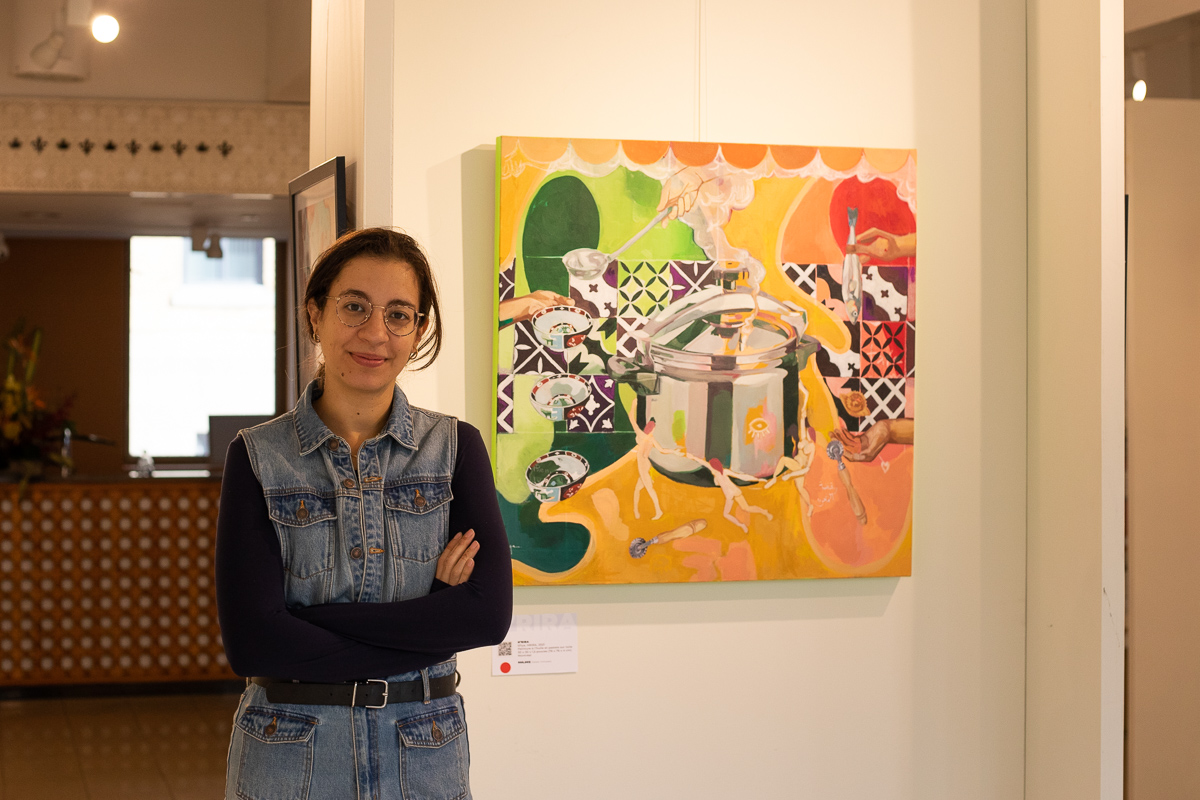Artist Safae Mounsif’s work presents a polarity between authentic representations of Morocco and distorted perceptions of the country
Montreal artist Safae Mounsif’s work is inherently dualistic: the very name of her exhibition, H’RIRA, refers to both the hearty Moroccan soup consumed during the month of Ramadan, as well as a Moroccan expression describing a state of chaos and anarchy. From Oct. 21 to Oct. 28, visitors were invited to browse Mounsif’s collection of 12 paintings. The artist’s work seeks to reframe and challenge outdated Moroccan notions by presenting aspects of the country’s culture through a surrealistic, chaotic approach. Identity plays a crucial role in H’RIRA; Mounsif’s work encourages the Moroccan community to take control of their narrative and reappropriate aspects of their culture that they may be stifling.
Mounsif moved to Morocco shortly after being born in Montreal. Four years ago, she returned to Montreal, where she began working as an interior designer. In 2020, she took a leap of faith and decided to quit her job, realizing that it was time to focus on painting. “For me, it was just time to take the risk,” she said. “I gave myself a year to make something out of it, because […] it was very important that if I quit my job, I need to have an alternative.”
Through the duration of the lockdown, Mounsif put her artistic talents to use and devoted her time to this project, one that ultimately took a whole year. Three months were dedicated solely to preparing H’RIRA for display. “I wanted it to be successful, so I spent a lot of energy just trying to find the right place for it. For me, it was very symbolic to do it at the Moroccan Cultural Centre (MCC) because it’s my own representation of Morocco.”
Mounsif felt that by hosting her exhibition here, it would allow for the MCC to gain more visibility, while also affording her the chance to showcase her work for free. She explained that most galleries take 50 per cent of commissions, but by hosting her exhibition at the MCC, she was able to claim 100 per cent of all painting sales. On top of holding her exhibition in a free space, Mounsif also decided to offer all of her pieces in print form. Purchasing these prints allow for visitors to support the artist while also receiving a unique work of art at a much more affordable price.
When admiring Mounsif’s work, one can discern a clear juxtaposition between many of the paintings. Most works are grouped into pairs, which helps to accentuate the clear differences between one work and the other. Take for example her two paintings titled QROUDA and HABIBI. Both paintings are placed on the wall, side to side. In the first one, there is a man playing a flute who is surrounded by several children and two macaques. This painting is, as Mounsif explained it, a rather accurate representation of the country as she knows it, even though this surreal version is painted in bright pastels. She also noted that, contrary to popular belief, Morocco is a colourful country. Many buildings in the country are saturated in vivid pastels and feature vibrant tile patterns.
HABIBI, contrasted to QROUDA, appears to be much more grounded, especially with its earthy tones and fixed subject. A man, perhaps the same one featured in QROUDA, lounges on a chair as he plucks at an oud, a stringed instrument. In lieu of children and macaques, this man is surrounded by four cats. He’s wearing a red tarboosh, a hat sometimes worn by Muslim men, and there is a pot of tea resting by his feet. The background of this piece is composed of several patterns similar to those found on Moroccan tiles, though much less colourful than the ones in the previous painting.
Mounsif explained that when she asks viewers, who are either from Morocco or elsewhere, which painting best portrays the country, they tend to choose the image that presents an orientalist depiction of Morocco, such as HABIBI. For her, these pieces don’t paint an authentic picture of life in the country. Instead, they seek to expose outdated notions of the country and its inhabitants.
When asked what she hopes viewers will take away from her paintings, Mounsif replied, “I think it depends on the viewers. I think for the Moroccan community, I want them to have another representation of themselves, I want them to know that we need to tell our stories and we need to be active regarding these representations.” Mounsif also hopes that her paintings will offer individuals who are not a part of the Moroccan community access to more realistic representations of the country and the Muslim community.
It is evident that H’RIRA is a deeply personal expression of the artist’s own identity while also functioning as a commentary on the enduring orientalist portrayals of Morocco. Mounsif’s paintings encourage viewers, wherever they come from, to examine what aspects comprise their own identities. Hopefully, they can learn to appreciate these aspects and create their own narratives according to who they are.
“[Identity] is something that is very important to me and I don’t think that we can just be passive about it,” Mounsif said. “I think that we cannot just endure our identity but somehow embrace it by knowing what it is made of.”
Mounsif noted that from Dec. 10 to 12, H’RIRA will be moving to La P’tite Porte, located at 1122 De Maisonneuve Blvd. Visitors will have the chance to browse Mounsif’s collection of work, and her prints will be up for sale. For more information on the artist, please visit her website.
Photo courtesy of Catherine Reynolds




